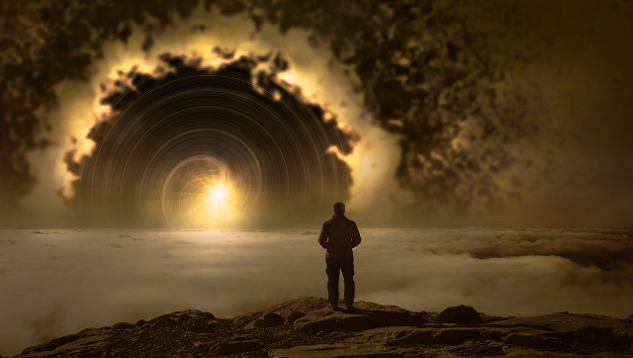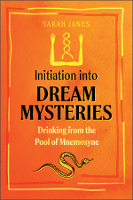
Image by Stefan Keller
What is dream incubation? Put simply, dream incubation is any technique or combination of techniques aimed at engendering a desired dream. For our ancestors this would most likely involve seeking out a divine entity or deceased person. This being might offer insight into the future, counsel, a miracle, a cure, or a spontaneous divine healing.
Traditionally, dream incubation preparatory rituals usually involved a combination of purging, catharsis, fasting, purification, sacrifice, offerings, prayer, magical writing and charms, pilgrimage to sacred sites, and sometimes dream-inducing via certain oneirogenic substances. Across Mesopotamia, the Levant, ancient Egypt and Greece, combinations of all of these techniques were employed.
The dream practices of cultures such as these—ones with advanced writing and recording systems as well as schools for elite priestly scribes—most certainly developed through the metaphysical lens of the non-literate cultures that predate them. The idea of making oneself “pure” is a sort of pagan precursor to the slogan “cleanliness is next to godliness.” By turning yourself into a clean and pure vessel, you bring yourself into alignment with the divine principle and invite holy favor.
As well, the influence of language and early writing on dreaming cannot be overstated. Writing is itself a magical act, and many ancient scripts evolved out of symbolic art and pictographic forms. As dream interpretation developed into a profession in ancient Near Eastern civilizations, it gives the appearance of being seen as a job primarily for the literate. Wordplay, punning, especially homophones—hinting at its non-literate roots, and association are the mainstays of classical dream interpretation texts in ancient Egypt, for example. I believe that human spiritual thought, and therefore many of our world’s cultures, gestated in a nexus of memory, language, and dreams.
Language programs our cultural memory and is fine-tuned in the consolidating processes of dreaming. Each night we reconfigure ourselves according to our world and reaffirm to ourselves who we are, where we are, and what our story is. So perhaps another way to look at dreams is to see that they provide an incubation realm for personality, a liminal zone in which the architecture of the psyche can evolve. Maybe this is why babies spend around 50 percent of their time in memory-organizing REM sleep—twice as much time as adults do. Perhaps in these luxuriously long REM sleep phases, babies are working extra hard to figure out who they are, where they are, and what their story is.
Dreamtime As A Mirror Realm
The dream realm has a hall-of-mirrors quality to it. In dreams we are able to see ourselves from multiple perspectives; we become all eyes, examining self from every angle. In ordinary consciousness it seems as though we exist as an independent entity. We occupy a sort of liminal state in which we have learned to peel our individual identity away from the rest of the cosmos. On the hidden side of the thin, reflective layer that is the awake I is the otherworld of dream us—a fractalized I, a shuffling self-image, eternally seeking some sort of coherence.
In the nascent field of geopsychology, studies have shown that personality traits can form in response to all sorts of external factors, including geology, weather, environment, landscape, and local culture. I believe we integrate this vast amount of data most intensively at night, slowly constructing our own inner mirror realm over a lifetime and using it as a space to organize and reconcile the experiences we have of the waking world.
Have you ever had the experience of rousing from sleep and suddenly not knowing who or where you are? It feels as though for a moment your entire identity is in suspension. Experiences such as this, a sort of parasomnia, or confused arousal experience, most commonly experienced by small children, make me wonder where exactly it is that our dreams take shape and play out.
Dreams and sleep clearly have extraordinarily important roles in memory-making and consciousness, but the complete system remains imperfectly understood. I wonder if the ancients, with their reverence for memory, ancestors, and the sophisticated mnemonic devices they developed for their oral storytelling traditions, had different, perhaps more entangled conscious and subconscious memory-processing faculties than we contemporary humans.
Humans nowadays seem to have outsourced much of their memory to the digital storage structures within the synthetic global brain of the all-pervasive internet. This universal neural network now appears to be orchestrating most of our lives. It has put something of a dent into our ability to remember and imagine, and this has manifested in what is known as “digital amnesia” or “digital dementia” and might even be a contributing factor in some cases of aphantasia, the inability to form mental images of people, places, and things.
Without coherent personal memories and a vibrant imagination, can we have good dream lives? Without good dream lives, what kind of waking lives do we lead? Many children have wonderful dream lives with many incidents of lucidity. Alongside other neurophysiological features of the youthful brain, much of this might be attributed to the amount of time young children spend in imaginative play.
Ancient Dream Oracles
In the ancient world, a dream oracle might have referred to a person—a professional dreamer, one who dreams on your behalf and predicts your future for you—or it could be one’s own prophetic dream, in which the future is revealed, usually by cryptic signs that might be further teased out by a dream interpreter. In ancient records, a dream of the future is rarely described as being a straightforward vision of events yet to unfold; it is more likely to resemble a kind of visual puzzle composed of dream signs, often visual representations of a word or words, that with expert rearrangement can come to write out the essential elements of the prediction.
The oracular nature of dreaming throughout the ancient world really fascinates me. I think it demonstrates that the human being functions as a prediction-generator and sense-maker, perhaps as a result of the unique niche we have come to occupy within the animal kingdom.
The development of art, games, architecture, and language gave us tools to represent the world as we saw it, and in doing so we came to create an imaginal, mental layer of reality, one of information, thoughts, ideas, and possibilities, very much like the concept of the noosphere as elucidated by Vladimir Vernadsky and Pierre Teilhard de Chardin. Even in our information-rich age—and paradoxically, considering our science-led culture—we seem to be returning to something of an oracular mind-set.
Making Sense of It All
We modern people are increasingly overwhelmed and saturated with information, as we desperately seek to find meaning, to make sense of it all, we disassociate. Our consciousness appears to fragment as it attempts to predict the future in an increasingly complex, furiously fast-changing and chaotic world.
Our salvation is where it has always been—in deep connection with nature and transcendent, rapturous experience.
Copyright ©2022. All Rights Reserved.
Adapted with permission of the publisher,
Destiny Books, an imprint of Inner Traditions Intl.
Article Source:
Initiation into Dream Mysteries: Drinking from the Pool of Mnemosyne
by Sarah Janes Sharing her more than a decade of research on Sleep Temples and Mystery Schools of the Esoteric Tradition, lucid-dreaming instructor Sarah Janes explores the evolution of imagination, memory, and consciousness throughout the ages and proposes that dreams have been fundamental in the creation and development of culture.
Sharing her more than a decade of research on Sleep Temples and Mystery Schools of the Esoteric Tradition, lucid-dreaming instructor Sarah Janes explores the evolution of imagination, memory, and consciousness throughout the ages and proposes that dreams have been fundamental in the creation and development of culture.
Explaining how a conscious dream life is essential for self-discovery, deep integration, and healing, Sarah presents exercises, techniques, initiations, and seven guided audio meditations to help you explore the inner depths of your psyche. Sarah reveals how dreams offer us an opportunity to remember and directly experience our divinity, to transcend the limitations of our mortality and enter timeless imaginal realms. These realms, accessible through dreams, can help you to form a better understanding of who you are.
Click here for more info and/or to order this paperback book. Also available as an Audiobook and as a Kindle edition.
About the Author
 Sarah Janes has been an enthusiastic lucid dreamer since childhood. She is a writer, public speaker, and sleep hypnosis workshop facilitator. She runs Explorers Egyptology, an online lecture series, and with Carl Hayden Smith operates the Seventh Ray, a mixed reality Mystery School. She is also producer and co-host for the Anthony Peake Consciousness Hour podcast.
Sarah Janes has been an enthusiastic lucid dreamer since childhood. She is a writer, public speaker, and sleep hypnosis workshop facilitator. She runs Explorers Egyptology, an online lecture series, and with Carl Hayden Smith operates the Seventh Ray, a mixed reality Mystery School. She is also producer and co-host for the Anthony Peake Consciousness Hour podcast.
Sarah is currently working with Dr. Mervat Nasser at New Hermopolis in Egypt and with Rupert Sheldrake and the British Pilgrimage Trust to reinvigorate the practice of dream incubation at sacred sites. She lives in Hastings, England.
Visit her Website at TheMysteries.org/























